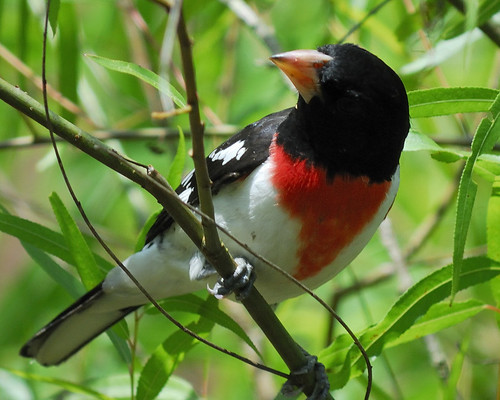tags: Rose-breasted Grosbeak, Pheucticus ludovicianus, birds, mystery bird, bird ID quiz
[Mystery bird] Rose-breasted Grosbeak, Pheucticus ludovicianus, photographed at Sabine Woods and Sabine Pass area, Texas. [I will identify this bird for you tomorrow]
Image: Joseph Kennedy, 28 April 2008 [larger view].
Nikon D200, Kowa 883 telescope TSN-PZ camera eyepiece 1/250s f/8.0 at 1000.0mm iso400.
Please name at least one field mark that supports your identification.
Rick Wright, Managing Director of WINGS Birding Tours Worldwide, writes:
Every birder has a "trigger" bird, and most of us have several. One of mine was a bright male Rose-breasted Grosbeak, perched high in a fruiting elm one May day in southeast Nebraska -- and identified with recourse to Arthur Singer's plates in the World Book [Birds of the World. This one's a beauty, showing all the plumage characters and, more importantly, all of the structural features we need to identify him.
If we imagine away those shocking colors, we can focus on the characteristics of shape that hold true across the age- and sex-classes of this species: the short tail, fat body, huge head, and truly "gros" beak.
This bird is obviously a male, but how old is it? Rose-breasted and Black-headed Grosbeaks take two years to attain full adult plumage; in their first year, they show a clear contrast between retained juvenile flight feathers and new adult feathers. This bird's wing, what we can see of it, at least, is uniformly glossy black, making it a bird at least two years old.


Male Rose-Breasted Grosbeak?
--Serious big beak.
--Rose breast
--white on black stripey effect on the backs of the wings (barely visible in photo)
(I could well be wrong, not knowing Texas birds much, but up here in the frozen north, that's what I'd think if I saw it. The stripey backs always impress me up here.)
Beautiful photo, too :)
Male rose-breasted grosbeak. No doubt about it. :)
This is one of my favorite birds, and I still remember the very first one I ever saw. I was living in Indiana, and had just started birding, by watching the birds that came to my backyard feeder. I'd slept on the couch that night, and when I woke up, I looked out into the yard and saw a black and white bird that looked like it was bleeding. The red was *that* vivid and bright. After I got done being worried about the injured bird in my yard (who wasn't acting injured, really), I took a look in my book and discovered he was supposed to look that way. So gorgeous.
Yeah, male Rose-breasted Grosbeak. Unmistakable.
I've never seen one of these in real life, but we had a few when the CONE Welder birdcam (in Texas) opened up for business back in late April of this year, but we haven't seen any there since May 5. I'm looking forward to their showing up again.
Perhaps it was passing through Texas on its way South.
In the book I have, Birds of North America, with the Smithsonian and Fred Alsop III, The Rose-Breasted Grosbeak does not occur in Texas. The map shows it summers in NE states and part of Canada, and winters in Mexico.
I believe I say this bird today in Riviera Texas. Does this bird come to South Texas? I am no bird expert, but I really do think I saw this bird here.
I live in Texas, down around Houston and for the last two days I have had a Male Rose-breasted Grosbeak coming to my feeders in my back yard.It really is a site to see.
We saw a male Rose breasted Grosbeak last night at our feeder. Must have been on it's way to Mexico. Port Isabel Texas
We live in Moody, Texas ... about 15 miles South of Waco, Texas.
We have had a beautiful rose breasted grosbeak at our feeder all day today. We have never seen one here before.
Also, for the last three days we have had SEVERAL Painted Buntings (bright blue, yellow, green & red males; and the females appear olive green with a lime sheen). We also have beautiful (bright blue) indigo buntings.
We can't pull ourselves away from the windows. :-)
I have seen a rose breasted grosbeak at my feeder. This is a first. I live in College Station, TX.
I have also seen this year, for the first time, a chat bird and an indigo bunting. I have also seen a brown thrasher around
Seems like an odd year, seeing all these species that I do not normally see.
In springs past, I'd have a few come around about this time of year. This year my yard and feeders are full of them. I love this bird and I call them my 'clowns'. There are males (juvies and adult) and females. They seem to rule the roost and let all the other birds wait their turn, including the woodpeckers who usually have their own way. I understand they winter in S. America and stop off here in Tn. on their way to N. Canada. Migration is an amazing thing.
I spotted my first one today on my collection of bird feeders. I lived in a small town in Michigan called Munith, near Jackson. Today is Friday June 11 2010.
We have had a male Rose breasted Grosbeak visit our back yard feeders several time this summer. This is one of the most beatuiful bird that come to our feeders. We also have Blue birds, Gold finches, cardinals, song sparrows (that sing a beautiful song) small wrens nest every year in the wren houses scsttered on our property. We are blessed and so thankful for the new addition this year of the Rose Breasted Grosbeak.